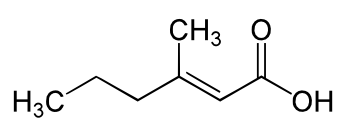
Bacterial Signature
November 12, 2015 Upstate New York, where I spent the early years of my life, is a vast forest occasionally punctuated by a small town or city. The larger cities of Upstate developed along the Erie Canal, a 584 kilometer waterway that links the Hudson River at Albany to Lake Erie at Buffalo. The only way such a waterway can function is by a system of locks that controls the flow of water through a differential elevation of about 172 meters. The canal opened in 1825. | A 1912 engraving of Lock No. 11, at Amsterdam, New York, of the Barge (née Erie) Canal. (Via Wikimedia Commons.) |
 | American Gothic (oil on beaver board, 1930) by Grant Wood (1891-1942) The number of farms in the US peaked at 7 million in 1935. There are just 1.9 million remaining, but with nearly the same total acreage as at the peak. (From the Friends of American Art Collection of the Art Institute of Chicago, via Wikimedia Commons.) |
 | Trans-3-Methyl-2-hexenoic acid (Wikimedia Commons image.) |
"We expected that we would be able to detect the human microbiome in the air around a person, but we were surprised to find that we could identify most of the occupants just by sampling their microbial cloud."[7]Bacteria associated with individuals are dispersed into the environment through direct contact and by bioaerosol particle emission from breath, clothes, skin and hair.[6] Humans shed about a million particles of size less than 0.5 micrometer every hour, many of which would contain bacteria.[6] In their experiments, the University of Oregon researchers sampled microbes from the air space of a single person sitting in a sanitized environmental chamber, and they compared that to air sampled in an adjacent, identical, unoccupied chamber.[6] They used high-throughput DNA sequencing methods to characterize the airborne bacteria.[6] In subsequent, higher resolution, experiments they sampled 8 different people for 90 min each with air flowing through a collection filter at on and three air change per hour.[6] Individuals could be distinguished through their airborne emissions in the chamber within 1.5-4 hours.[6] They authors comment that their experiments might help to understand the mechanisms involved in infectious disease transmission in buildings.[7] At this point, considerable time is involved in detection, but there might be potential forensic applications.[7] Perhaps the surveillance society might be worse than we imagined.
References:
- Len Barcousky, "Eyewitness 1842: Dickens finds Pittsburgh full of smoke and fires," Pittsburgh Post-Gazette, August 30, 2015.
- Christopher Weber, "Stink Wars: When a Foul Wind Wafts From a Farm, Is it a Problem?" Modern Farmer, January 27, 2014.
- John P. Chastain, "Odor Control From Poultry Facilities," Chapter 9 of Poultry Training Manual, Clemson Cooperative Extension.
- Napoleon supposedly wrote in a letter to Josephine, Ne te lave pas. Je reviens. (Don't bathe. I'm coming home.)
- M. Kaitz, A. Good, A. M. Rokem, and A. I. Eidelman, "Mothers' recognition of their newborns by olfactory cues," Developmental Psychobiology, vol. 20, no. 6 (November, 1987), pp. 587-591.
- James F. Meadow, Adam E. Altrichter, Ashley C. Bateman, Jason Stenson, GZ Brown, Jessica L. Green, Brendan, and J.M. Bohannan, "Humans differ in their personal microbial cloud," Peerj, vol. 3, Document No. e1258 (September 22, 2015), DOI: 10.7717/peerj.1258.
- New research finds that people emit their own personal microbial cloud, Peerj PressRelease, September 22, 2015.